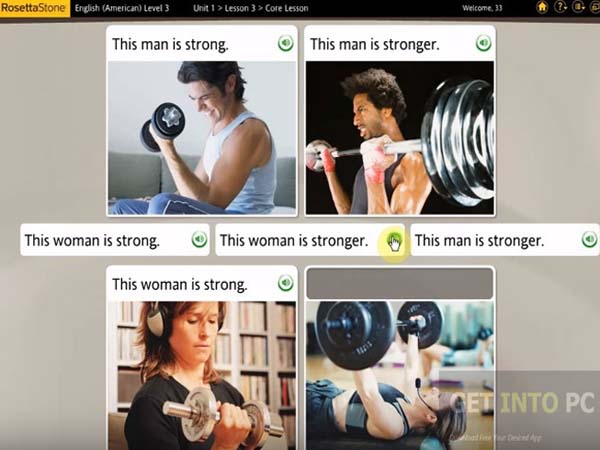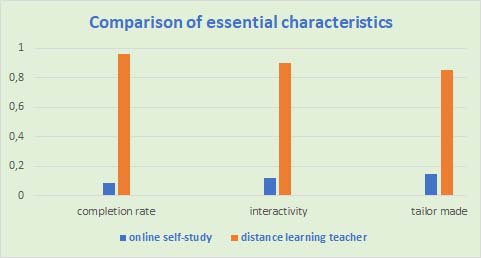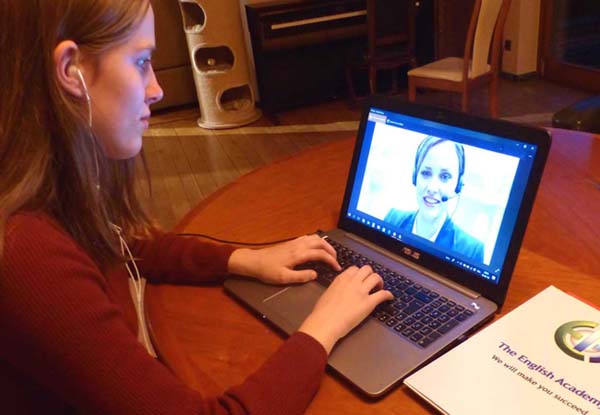There are many ways of learning a language using your PC, tablet or mobile phone, all of which are referred to as online English lessons or English exercises online.
These terms often cause misunderstandings among students looking to improve their English but unsure of what exactly is meant by the term ‘English exercises online’.
Let us therefore first define the different ways you can master a new language via the internet: the first being online self-study and the second, distance learning with a teacher.
1. Online self-study

og in and start studying on your own!
This method means that you log in to access lesson material, allowing you to study on your own and do English exercises to check how well you have mastered new information. You can do the units or chapters online in a logical order and check your mistakes, all at your own pace.
hink of it as a digital course book
Simply imagine that your course book, your exercise book and your audio CD are all online. You don’t have to carry this didactical material with you – you don’t even physically have it anymore – but you log in and get started.
Essentially, this means your study material is always available online. There is no interaction with a tutor or other students.


an you learn a language this way?
Yes, you can, if you have the motivation and self-discipline required by such a method. With no teacher expecting a result by next week and no commitment to a regular timetable, this technique offers unparalleled flexibility.
We do, however, strongly advise you to fix your lesson time upfront so that you don’t end up putting off your lessons or procrastinating.
s it cost and time efficient?
Let us consider the cost. Most of the study material that you can find for free online is of poor quality and contains numerous errors, impeding your ability to effectively improve your English.
If you don’t want to waste your time and energy, you should buy a good online self-study package, such as Rosetta Stone or similar professional solutions. But such a language course comes at a price, often 300 to 400 Euro or even more. It is thus highly preferable to know how effective this kind of approach is likely to be for you before spending a lot on it.
very high dropout rate.
According to Actiris, the unemployment service of Brussels that we collaborate with , 91% of the users of their well-known online self-study language courses with theory and exercises of English, Dutch, French and German give up studying prematurely, since there is nobody to talk to and to motivate them.
o know if it is likely to work for you: answer one question.
That question is: How able am I to commit to a schedule of regular study with a course book?
Judge your ability to study regularly with a conventional course book. If you finished your Assimil in no time, and now want to take your language learning further, you will probably make good progress with an online self-study language course.
If, on the other hand, you are more likely to deposit your course book on your shelf to gather dust, an online course is probably not the optimal solution for you.
After all, the contents of a physical book and an online course are largely the same. Only the medium you use to access the information is different.
onclusion on online English self-study programmes and apps.
This method can be a good solution for very motivated students to learn new vocabulary and grammar. While its primary advantage is enhancing a student’s comprehension of the language, it has the added benefit of being accessible whenever and wherever you want, giving you a huge amount of flexibility.
However, this may be a disadvantage if you have trouble getting motivated, as shown by the undeniably high dropout rates for this kind of course.
The biggest downside of an English self-study programme with online exercises is undoubtedly the lack of speaking and pronunciation practice. This may get in the way of your ability to express yourself fluently when using the language abroad.
While we recognise the utility of self-study courses of English and other languages to supplement a regular course with a teacher, we do not recommend them as a standalone learning method in most cases.
Let us now move on to the second type of online language learning.
2. Distance language learning with a teacher

ou are communicating with a real person.
This type of online learning is very different from the one explained above. Here, you have a live English teacher and planned language lessons. You talk to your teacher and can even see him or her for the entire duration of your class. You can share documents, links or exercises, depending on your needs and preferences, making it a tailor-made private language class.
s if you were sitting at the same table.
Image that you are sitting in a classroom with your private teacher, who guides you through the new information, clarifies any difficulties you might have, stimulates you to speak and then corrects your mistakes and exercises instantly.
Well, this is the same thing. The only difference is that you communicate with your teacher online instead of sitting in the same room or office.


hat kind of technology is used?
You are probably thinking of Teams, Zoom or similar VoIP solutions.
However, technology has moved on and other, more powerful solutions are available, including virtual classrooms where you can share a whiteboard, notes and files, although WhatsApp can be used for conversation lessons.
Communication is no longer a problem. You should ask about the quality of your teacher instead. That is what will make the difference between failure and success.
hat does a good online language teacher look like?
Wherever you want to register, make sure the organisation you choose applies the same criteria as the English Academy when hiring language teachers:
1. They must have a degree as a foreign language teacher with relevant professional experience.
2. They can only teach their own mother tongue and no other language.
3. They should be constantly supervised and evaluated by a language school.
If these criteria are not applied, you might not make the progress you expected and draw the mistaken conclusion that you are not up to learning a new language.
onclusions about distance learning with a teacher.
It generally produces much better results than an online self-study course, since only 4% of our students give up before the end of their course. This is an enormous difference.
The added value lays in the interaction with an experienced native English speaker who is qualified as a language teacher. This trainer will guide and motivate you to learn and to speak English and will correct your mistakes and personalise the course content.
The communication tool is no longer an issue, since virtual classroom technology allows you to enter your course with a single click.
There is, however, a third solution possible.
3. ‘Blended Learning’, a combination of the two previous methods
What is Blended learning?
‘Blended’ means that this form of course is a mixture of two or more different elements.
You can have a lesson with a real ‘live’ teacher in a virtual classroom, do exercises in your online workbook and carry around a printed copy of your course book that you can open anytime and anywhere. In this example, you can see a blend of three different learning tools.
personalised solution for every course.
If you want to practise your conversation skills, interaction with your teacher will be the most important tool. If, however, you want a more structured course, including the revision of all skills, we can send to you a printed course book via Amazon. It really all depends on your personal situation.
Efficient English exercises online should be tailor-made: adapted to your preferences, your level, your needs and the total duration of the training programme.
Summary
There are different ways you can learn English or another language online, in the comfort of your home or office:
